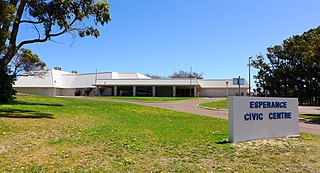Related Research Articles

Esperance is a town in the Goldfields–Esperance region of Western Australia, on the Southern Ocean coastline approximately 720 kilometres (450 mi) east-southeast of the state capital, Perth and 189 kilometres (117 mi) south of Norseman. The urban population of Esperance was 12,145 at June 2018. Its major industries are tourism, agriculture, and fishing.

Challicum Hills Wind Farm is a wind farm encompassed by 35 NEG NM 64 wind turbines, with a total generating capacity of 52.5 MW of electricity. The wind farm is near Ararat in western Victoria, Australia. The power station was commissioned in August 2003 and is in a long term Power Purchase Agreement (PPA) with Origin Energy.

Starfish Hill Wind Farm is a wind power station spread over two hills near Cape Jervis, South Australia. It has 22 wind turbines, eight on Starfish Hill itself and 14 on Salt Creek Hill, with a combined generating capacity of 33 MW of electricity.
Cathedral Rocks Wind Farm is a wind power station located about 30 km west of Port Lincoln in South Australia, near the southern tip of the Eyre Peninsula. It has 33 wind turbines of 2 MW each, with a combined generating capacity of 66 MW of electricity. The site covers an area of about 29 km2, with a coastal exposure of nearly 11 km and is private farming land. The wind farm was commissioned in September 2005.

Wind power, a form of renewable energy harnessed through wind turbines, stands as a pivotal contributor to Australia's energy landscape. With a total installed wind capacity reaching approximately 9,100 megawatts (MW) as of October 2023, wind power constitutes a significant portion, representing 5% of Australia's total primary energy supply and a substantial 35% of its renewable energy supply. Australia's geographic disposition favours the proliferation of wind energy infrastructure, particularly in the southern regions of the nation and along the slopes of the Great Dividing Range in the east. Approximately half of Australia's wind farms are located near coastal regions.

The Mount Millar Wind Farm is situated on an escarpment between the towns of Cowell and Cleve on the Eyre Peninsula in South Australia. The 35 wind turbines are positioned on the elongated Mount Millar site to maximise wind exposure. The wind farm can generate up to 70 megawatts (MW) of electricity and provide enough energy to meet the needs of about 36,000 typical households.

Wind power became a significant energy source within South Australia over the first two decades of the 21st century. In 2015, there was an installed capacity of 1,475 MW, which accounted for 34% of electricity production in the state. This accounted for 35% of Australia's installed wind power capacity. In 2021, there was an installed capacity of 2052.95 MW, which accounted for 42.1% of the electricity production in the state in 2020.

Ten Mile Lagoon wind farm is situated on a coastal ridge 16 kilometres west of Esperance in Western Australia, and it lies in the northern extremities of the reliable Roaring Forties winds. It was Australia's first commercial wind farm that is still operating, and consists of nine 225 kW Vestas wind turbines giving a total generating capacity of just over 2 Megawatts. The farm was established in October 1993, after the successful operation of a smaller experimental wind farm at Salmon Beach, Esperance.

The Shire of Esperance is a local government area in the Goldfields-Esperance region of Western Australia, about 400 kilometres (250 mi) south of the town of Kalgoorlie and about 720 kilometres (450 mi) east-southeast of the state capital, Perth. The Shire covers an area of 42,547 square kilometres (16,427 sq mi), and its seat of government is the town of Esperance, where about three-quarters of the Shire's population resides.

The Emu Downs Wind Farm is a 79.2 MW wind farm in Western Australia. It was a 50:50 joint development between Griffin Energy and Stanwell Corporation. The site is approximately 200 kilometres north of Perth, near Cervantes. Construction of the $180 million project commenced in November 2005, and the project was commissioned in October 2006.

The Waubra wind farm is located on both sides of the Sunraysia Highway 35 km north-west of Ballarat in Victoria, Australia. Upon its completion in July 2009, it was the largest wind farm in Australia and was the largest wind farm by number of turbines and total capacity in the southern hemisphere.

Biglow Canyon Wind Farm is an electricity generating wind farm facility in Sherman County, Oregon, United States. It is owned by Portland, Oregon-based Portland General Electric and began operations in 2007. With the completion of phase 3 of the project it has a generating capacity of 450 megawatts. It is located roughly five miles (8 km) northeast of Wasco, Oregon, and about ten miles (16 km) southeast of Rufus, Oregon. Biglow Canyon Wind Farm covers 25,000 acres (10,000 ha) in the Columbia River Gorge.

The Mount Mercer Wind Farm is located at Mount Mercer approximately 30 kilometres south of Ballarat in Western Victoria on 2600ha. The wind farm consists of 64 REpower MM92 wind turbines, giving a total installed capacity of 131 MW. It is expected to generate approximately 395,000 megawatt hours (MWh) of electricity each year which could power approximately 74,000 households and result in a reduction of some 510,000 tonnes of carbon dioxide.

The Hepburn Wind Project is a wind farm built and owned by Hepburn Wind, a community co-operative, and supported by the Victorian Government. The location of the project is Leonards Hill, 10 kilometres (6.2 mi) south of Daylesford, Victoria, north-west of Melbourne, Victoria. It comprises two individual 2.05 MW wind turbines supplied by REpower System AG which are projected to produce enough energy for 2,300 households when the wind is blowing, almost as many houses are in the twin-towns of Daylesford and Hepburn Springs.

Meadow Lake Wind Farm is an 801.25 megawatt (MW) wind farm near Brookston and Chalmers, Indiana, spreading over portions of White, Jasper, and Benton Counties. It is owned and operated by EDP Renewables North America. The facility currently has six operational phases, with 414 turbines, and is a prominent feature on both sides of Interstate 65 in western Indiana.
In 2016, Arizona had 268 megawatts (MW) of wind powered electricity generating capacity, producing 0.5% of in-state generated electricity.

Esperance Land District is a land district of Western Australia, located within the Eucla Land Division on the state's south coast. It spans roughly 33°15'S - 34°00'S in latitude and 121°00'E - 122°20'E in longitude.

Collgar Wind Farm is a wind farm located approximately 25 kilometres south-east of Merredin, Western Australia. It is operated by Collgar Renewables. With 111 Vestas V90-2.0MW wind turbines, and a total installed capacity of 222 MW registered with AEMO, it is Western Australia's largest wind farm. It became fully operational in October 2011 and is expected to generate 750 GWh per year on average over the 30-year life of the project.

Infigen Energy (Infigen), operating under this name since 29 April 2009, is a developer, owner and operator of renewable energy generation assets in Australia. Infigen's wind farm portfolio has an installed capacity of 557 MW. Most of Infigen's assets generate electricity from renewable sources and are eligible to sell Large-scale Generation Certificates (LGCs) under the mandatory Renewable Energy Target scheme, which operates in Australia under the Renewable Energy (Electricity) Act 2000. Since 2020, Infigen Energy has been a subsidiary of Iberdrola.

The East Anglia Array is a proposed series of offshore wind farms located around 30 miles off the east coast of East Anglia, in the North Sea, England. It has begun with the currently operational East Anglia ONE, that has been developed in partnership by ScottishPower Renewables and Vattenfall. Up to six individual projects could be set up in the area with a maximum capacity of up to 7.2 GW. The first project, East Anglia ONE at 714 MW, received planning consent in June 2014 and contracts in April 2016. Offshore construction began in 2018 and the project was commissioned in July 2020. It is expected to cost £2.5 billion.
References
- ↑ "Esperance Wind Farms". HorizonPower.com.au. Archived from the original on 13 September 2009. Retrieved 20 September 2009.
33°53′42″S121°46′51″E / 33.89500°S 121.78083°E
